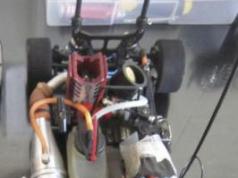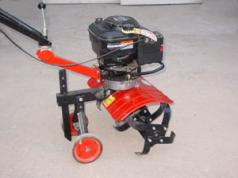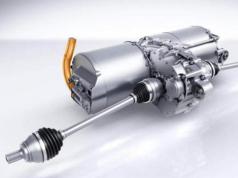The hydraulic compensator or, as it is also commonly called, the hydraulic valve tappet is a hydromechanical device that can change its length. It must compensate for the thermal gap between the valves and the camshaft and is the main component for automatic valve adjustment.
The hydraulic compensator includes an outer cylinder and a movable inner part, which is repelled by a spring. In the cavity of the hydraulic compensator, at the inlet, there is a valve consisting of a ball pressed by a spring. What helps the hydraulic valve lifter change its length?
The principle of its operation is to increase the length due to the spring inside, which is able to bring the uncompressed valve tappet to the state of maximum length. When the inner part is extended, the filling of the hydraulic compensator cavity with what was around begins through the valve.
If you hold the hydraulic pusher in your hands, it will be filled with air, and if it is mounted on the engine, it will be filled with oil. The compression process of the hydraulic valve lifter is somewhat more complicated, since the valve practically does not allow oil back through. A small amount of oil still comes out, through small distances between the rubbing surfaces. When the working pusher is compressed, you will not see the oil exit.
The hydraulic compensator is installed so that the outlet is directed upwards, it will serve as a support for the rocker arm or, as they say, a rocker, which will cover the outlet. A hole is provided in the rocker arm, through which oil should come out of the hydraulic pusher and a jet is fed to the rocker bearing, this is how it is lubricated. The principle of operation of the hydraulic valve tappet is simple, everything will depend on the force with which the pressure is applied, it is able to pick up oil through the intake valve or squeeze it out through tiny gaps.
If the hydraulic valve tappet is in good working order, it will hold pressure perfectly when filled with oil. When the hydraulic lifter is removed, it is easy to check it; when you try to compress it, you will not succeed, if even the minimum compression succeeded, then such a pusher requires replacement.
But if we assume that air has entered the pusher, then the compression, quite possibly, to check it will need to be filled with oil and again try to compress. If one of the hydraulic lifters fails, then the best solution would be to replace all the pushers, because their service life is approximately the same and the remaining ones will not last long.
It is possible to recognize the failure of the hydraulic compensator, the main symptom of their malfunction will be the appearance of a ringing knock in the engine, at first on an unheated, cold engine, and over time on a warm one.
Sometimes, the noise that the valves make can be eliminated. To do this, you will need to slightly turn the spring or valve around the longitudinal axis.
- Turn the crankshaft so that the noisy valve starts to open slightly.
- Unfold the spring slightly, and the valve will unfold with it.
- Start the engine and listen. If the noise remains, then the operation should be repeated with the valve and spring.
- If it is impossible to eliminate the noise by turning the valve and the spring, then it is worth checking the condition of the latter. This measures the gaps between the valve guide sleeve and the valve stem and then removes it if necessary.
- If the clearances are within normal limits and the valve with the spring is in good condition, and when the engine is running, you still hear the knock of the valves, then the hydraulic valve tappets will have to be replaced.
How to independently replace engine hydraulic lifters on a Hyundai Accent?
It is not necessary to remove the cylinder head from the engine to replace the hydraulic valve lifters. Removing the camshaft housing is sufficient for replacement. Remember, when removing the housing, the head gasket will have to be replaced with a new one to avoid a leak when tightening the bolts.
Preparatory work
Fill a new hydraulic compensator with oil. To do this, you need to completely lower the pusher in a container with oil and squeeze it there several times. In this case, bubbles will rise, coming out of the central hole, you need to squeeze until the bubbles stop. After the hydraulic lifter is completely filled with oil, you can start installing it on the engine.
Replacing hydraulic pushers on a Hyundai Accent
- Unscrew and remove the cover from the cylinder head.
- Remove the rocker arm, cracker, which is located on the valve stem and the camshaft.
- Pull the hydraulic valve tappet out of its seat in the cylinder head.
- Lubricate the engine socket with oil and take the previously prepared new hydraulic compensator. Install it in the socket.
- By analogy, replace all remaining hydraulic lifters.
- Reinstall the camshaft and other removed parts in reverse order.
Before starting work on replacing hydraulic lifters, it is necessary to wait until the engine has cooled down, it will take about half an hour, but it is required in order to reduce the oil pressure in the hydraulic valve lifters.
The hydraulic valve tappet is located inside the cylinder head seat with minimal interference and can be easily removed without the need for special tools. But it will be most convenient to use a rubber suction cup.
When the hydraulic lifters are replaced and the engine is started for the first time, it is possible that for some time there will be increased noise during operation, but do not worry. The hydraulic lifters will fully pump and all extraneous noise will stop.
Replacing the hydraulic lifters of the Hyundai engine Accent refers to engine repair work, and should be performed with certain skills.
What are hydraulic lifters?
Hydraulic clearance compensators transmit the force from the camshaft to the valves. They function as clearances in the drive and look like self-adjusting pressure arm bearings.
The principle of operation of hydraulic lifters
Pressurized oil is supplied to the internal cavities of the hydraulic compensator through the channel of the engine lubrication system through the side hole in the pusher. The hole is made in the annular groove of its cylindrical surface. When the valve is closed, the tappet is pressed against the camshaft cam and the sleeve is pressed against the end of the valve stem. When the pressure in both cavities is the same, the hydraulic lifter check valve is spring pressed against the seat in the plunger. In this position, there are no clearances as such in the valve mechanism. When the camshaft rotates, the cam runs over the tappet, thus moving it and the plunger. The movement of the plunger in the sleeve provokes a sharp increase in pressure in the cavity. The pusher together with the sleeve moves and opens the valve. Further, the distribution wad rotates, as a result of which the cam reduces the pressure on the follower. The oil pressure in one cavity is lower than in the other. The check valve opens, allowing oil to pass from a cavity connected to the engine oil line to another cavity. The pressure in it increases, the sleeve and the plunger move relative to each other and select a clearance in the valve mechanism.
Symptoms of malfunction of the hydrocapmenters
The main symptom of a malfunction of the hydrocapmenters is the noise during the operation of the gas distribution mechanism.
How to eliminate valve noise?
Before changing the hydraulic compensator, the noise of the valves can be tried to be eliminated by slightly turning the spring and the valve that makes the noise. It is also worth checking the condition of the spring.
Replacement of hydraulic compensators of the engine
To replace a part, you need:
- Remove the camshaft housing
- Remove the pressure lever and the cracker, which is installed on the valve stem
- Pull out the hydraulic lifter from the socket in the block head
- Lubricate the new hydraulic lifter and the seat itself with engine oil
- Reinstall the parts in reverse order.

How to replace hydraulic lifters on a Hyundai Accent car with your own hands without special training, having a standard set of tools for a motorist.
Old hydraulic lifters are pulled out of the wells using a flashlight, which has magnets at the end, this way to get them is very convenient, new ones are put only with the help of your hands.
How much does it cost to replace hydraulic lifters on a Hyundai Accent in a car service? At prices for 2015, all spare parts come out about 6 thousand rubles, plus the price tag for this work in an average auto service is more than 10 thousand rubles. Two torque wrenches used in the video, too, not everyone has, their price is 3-4 thousand.
DIY Hyundai Accent hydraulic lifters replacement video:
The Hyundai Accent engine is picky about the quality of oil, I recommend pouring Addinol 5W-40, there have not been any fakes of it yet, since it is quite rare. If you have a need, then at the same time you can replace the valve stem seals so that they can be disassembled less the next time, although for this you need a valve desiccant.
New expansion joints may continue to knock when the engine is first started, this is normal, they need time to be pumped with oil pressure from the cylinder head. During operation, the engine cools down, the oil pressure is low.
Mileage of the car before replacing hydraulic lifters 110 thousand km.
Hydraulic compensators compensate for the thermal gap between the camshaft and the valves by changing their own length to automatically adjust the valves. They consist of an outer cylinder and a spring-mounted movable part. At the inlet of the device there is a valve - a ball, pressed by a spring. In the process of extending the inner part, the cavity of the compensator is filled with oil. Reverse compression of the mechanism occurs with force - the valve does not release oil. From the outlet, oil is supplied to the rocker bearing.
How to get to the hydraulic lifters?
Everything can be done manually - no hydraulic suction cup needed. Before replacing, we wait for the engine to cool completely - the oil pressure will be minimal. It is important to secure the pulley so that it does not move. Along the way, it is advisable to replace the cylinder head gasket with a new one. New hydraulic lifters are filled with oil before installation. The compensator is lowered into the filled container, squeezed several times until the bubbles stop coming out. For disassembly you will need a jack, keys and screwdrivers:
- Unscrew the screws and remove the cylinder block cover.
- The belt pulley has a round hole. It needs to be aligned with the red notch on the left of the cylinder head. You need to raise the right wheel with a jack and turn it until it matches.
- With a pair of clamps, firmly fix the pulley with the belt to each other.
- On the sprockets and the camshaft chain, the marks should point in opposite directions. You can additionally mark the position with a marker.
- The camshaft chain can now be removed. We remove it with one sprocket, leave the part with the belt pulley.
- Hyundai Accent hydraulic lifters are easy to remove without special tools. Four of them near the belt pulley are removed after raising the camshaft, you still need to move the pulley. Due to the fixation with clamps, it does not move.
- When reassembling, avoid overtightening the bolts and do not use a torque wrench.
After replacement at start-up, the engine makes more noise than usual - this takes place after the expansion joints are completely “pumped” with oil.
When do you need to replace hydraulic lifters?
The hallmark is a ringing sound at a cold start of the Hyundai Accent. In advanced cases, a knock is heard at every start. The removed hydraulic lifter is very easy to check: try to squeeze it - without air inside it is impossible. If even a little gives in, it is imperative to change. You don't need to check everything, just one is enough. The service life is approximately the same, the "bells" from all compensators will go further.
The described noise effect on the Accent is not always caused by a malfunction of the hydraulic lifters. Sometimes turning around the valve and spring axis is sufficient. By turning the crankshaft, we achieve that the noisy valve begins to open slightly. Lightly, with a small step, the spring with the valve unfolds. We start the engine and listen, if the knock remains, we do it again. You may need to tighten the spring - we measure and eliminate the gaps between the bushing and the guide. If it does not help, we change the hydraulic lifters.
Video: Replacing Hyundai Accent hydraulic lifters







